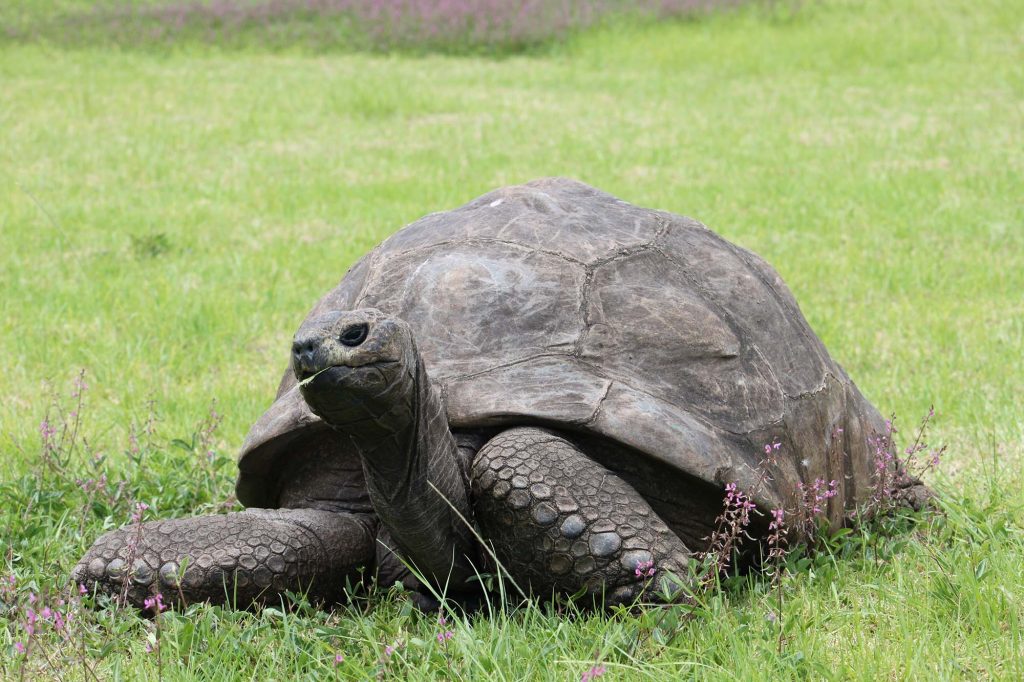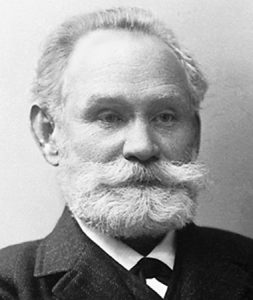The Oldest Living Land Animal Teaches a Master Class in Pavlovian Conditioning

Image above: Jonathan the tortoise, March 2020. Kevstan, CC BY-SA 4.0, via Wikimedia Commons
As he nears 200 years of age, Jonathan the tortoise has been receiving a great deal of international attention. However, longevity is not the only reason why we should find Jonathan to be of special interest. He’s confirming what Pavlov said about conditioning a century ago: It isn’t just about salivation!
Jonathan is a giant tortoise (Aldabrachelys gigantea hololissa) who, in 1882, was shipped from his original home in the Seychelles Islands in the Indian Ocean to Saint Helena—a volcanic tropical island and British Overseas Territory located in the South Atlantic Ocean some 1,200 miles off the west coast of Africa. Jonathan is estimated to be 192 years old, having “officially” hatched on December 4, 1832, making him the oldest living land animal according to the Guinness Book of World Records (Atwal, 2022). Jonathan turns out to be Saint Helena’s second most famous expatriate inhabitant, its first being Napoleon Bonaparte, who was exiled there in 1815 in the wake of his ignominious defeat at the Battle of Waterloo.
Jonathan is still in fine fettle despite his advanced age, thanks in great measure to the assiduous care he’s received for the past 15 years from veterinarian Joe Hollins. Although the nearly 400-pound chelonian has lost his senses of smell and sight, his hearing is quite acute. That enduring sense is crucial to the vital lesson Jonathan teaches us about Pavlovian conditioning.

Biting the air
Hollins has made a number of astute observations of Jonathan’s feeding activity: “He knows my voice and comes to me like a dog, but I have to accept it is mainly Pavlovian because he associates me with food” (Free, 2022). Further elaborating, Hollins stresses the fervor of Jonathan’s Pavlovian reactions: “He recognizes my voice when I approach and call to him softly. He literally jerks to attention and starts biting the air” (Free, 2024).
There’s no mystery as to how such Pavlovian conditioning has taken place. For many years, Hollins’s voice has consistently preceded Jonathan’s weekly repast of fresh fruit and vegetables—variously including bananas, apples, pears, carrots, cucumbers, cabbage, and hearts of lettuce—which supplement the giant tortoise’s far less delectable fare of grass and clover.
Now, by way of comparison, consider Pavlov’s (1934) characterization of the conditioned motor responses exhibited by his dogs:
The first reaction elicited by the established conditioned stimulus usually consists in a movement towards the stimulus, i.e., the animal turns to the place where the stimulus is to be found. If the stimulus is within reach, the animal even tries to come in touch with it, namely, by means of its mouth. Thus, if the conditioned stimulus is the switching on of a lamp, the dog licks the lamp; if the conditioned stimulus is a sound the dog will even snap at the air (in case of very heightened food excitability). (p. 187)
The resemblance between Pavlov’s description of his dogs’ conditioned responding and Hollins’s description of Jonathan’s conditioned responding is striking. What is also striking is that the specific behaviors being highlighted—orienting, approaching, and biting—are overtly directed toward the conditioned stimulus, whether it be visual or auditory.
So, what’s happened to that most exemplary of Pavlovian conditioned responses—salivation?
Nothing at all. Both dogs and tortoises avidly salivate and manipulate food in their mouths. Pavlov’s strong focus on salivation as the target response in much of his other scientific writings was the natural extension of his prior research in digestion, for which he was awarded the Nobel Prize in Physiology or Medicine in 1904. In addition, while conducting that work, Pavlov diligently devised highly accurate methods to measure secretory activity; similarly accurate measures were not then available to investigate motor activity. Finally, Pavlov dedicated himself to providing an entirely objective explanation of his pioneering findings. He firmly believed that focusing on dogs’ salivation would be more conducive to achieving this goal than would focusing on dogs’ directed motor responses for the simple reason that, in the case of secretory responses, there would probably be a “much smaller tendency to interpret them in an anthropomorphic fashion” (1927, p. 18).
Fine-tuned responses
By integrating his meticulous measurements of salivary secretion with his more informal observations of directed motor activity, Pavlov was able to propose a comprehensive theory of associative conditioning. Here’s how Pavlov explained this theory: Although animals may be equipped by evolution with a host of generally adaptive inborn responses, many of those responses may not be suited to the specific environmental conditions that animals encounter in their everyday lives. Those particular conditions may demand more fine-tuning, which becomes the business of the brain—the bodily organ that can effectively and flexibly link adaptive behaviors with environmental stimuli. To this key function of the brain Pavlov gave the name signalization, and to these experientially acquired signals he gave the name conditioned stimuli (1927, pp. 16–17).
Pavlov’s laboratory experiments famously showed that “artificial” conditioned stimuli (such as a ticking metronome) that are arbitrarily paired with food, as well as “natural” conditioned stimuli (such as the smell and sight of food) that are ordinarily paired with food in the development of a dog’s normal feeding behavior, could each serve as highly effective signals. Indeed, in the latter case, Pavlov surprisingly documented that puppies do not unconditionally salivate to the smell or sight of foods like meat and bread; only after the puppies had previously eaten those foods did their smell or sight come to trigger salivation.
Pavlov had one more critical point to make about signalization. Yes, it is highly adaptive for the proximal presentation of food in the mouth to unconditionally stimulate copious quantities of saliva, and in so doing to promote swallowing and digestion. Of even greater importance, however, is for the distal presentation of a signaling stimulus to conditionally elicit the motor components of nutrition, thus instigating the pursuit of food (1927, pp. 13–14). After all, you can’t eat the food if you don’t first detect its presence, approach it, and then seize it. Hence comes Pavlov’s bold exclamation: “How many simple physiological reflexes start from the nose, the eye, and the ear, and therefore originate at a distance!” (1928, p. 51).
In Pavlov’s theory of signalization, the movement reactions of animals are put front and center in a fully integrative analysis of adaptive behavior: “By means of distant and even accidental characteristics of objects the animal seeks his food, avoids his enemies, etc.” (1928, p. 52).
As noted earlier, Jonathan has lost his senses of smell and sight. Yet, his still-functioning sense of hearing enables Jonathan to locate Hollins, to approach him, and, in a state of heightened food excitability, to bite at the air—just like Pavlov’s dogs.
Hatched some 17 years before Pavlov’s birth and living some 88 years after Pavlov’s death, Jonathan provides persuasive support for Pavlov’s theory of conditioned responding. Adaptive behaviors—both secretory and motor—can be refined by experiences that are unique to an individual animal through the participation of the distance receptors and the brain. Signalization thus represents the theoretical complement to Pavlov’s pioneering empirical investigations—a theory that makes it clear that Pavlovian conditioning was never just about salivation.
Feedback on this article? Email apsobserver@psychologicalscience.org or login to comment.
Atwal, S. (2022, January 12). 190-year-old Jonathan becomes world’s oldest tortoise ever. Guinness World Records. https://www.guinnessworldrecords.com/news/2022/1/190-year-old-jonathan-becomes-worlds-oldest-tortoise-ever-688683
Free, C. (2022, January 30). The world’s oldest living land animal? At age 190, it’s Jonathan the tortoise. Washington Post. https://www.washingtonpost.com/lifestyle/2022/01/31/oldest-animal-tortoise-jonathan-/
Free, C. (2024, January 1). Happy 191st (or so) birthday to the world’s oldest living land animal. Washington Post. https://www.washingtonpost.com/lifestyle/2024/01/01/jonathan-tortoise-oldest-land-animal
Pavlov, I. P. (1927). Conditioned reflexes: An investigation of the physiological activity of the cerebral cortex. Translated and edited by G. V. Anrep. Oxford University Press.
Pavlov, I. P. (1928). Lectures on conditioned reflexes: Twenty-five years of objective study of the higher nervous activity (behaviour) of animals. (W. H. Gantt, Trans.). Liverwright Publishing Corporation. https://doi.org/10.1037/11081-000
Pavlov, I. P. (1934). An attempt at a physiological interpretation of obsessional neurosis and paranoia. Journal of Mental Science, 80, 187–197. https://doi.org/10.1192/bjp.80.329.187-a





APS regularly opens certain online articles for discussion on our website. Effective February 2021, you must be a logged-in APS member to post comments. By posting a comment, you agree to our Community Guidelines and the display of your profile information, including your name and affiliation. Any opinions, findings, conclusions, or recommendations present in article comments are those of the writers and do not necessarily reflect the views of APS or the article’s author. For more information, please see our Community Guidelines.
Please login with your APS account to comment.